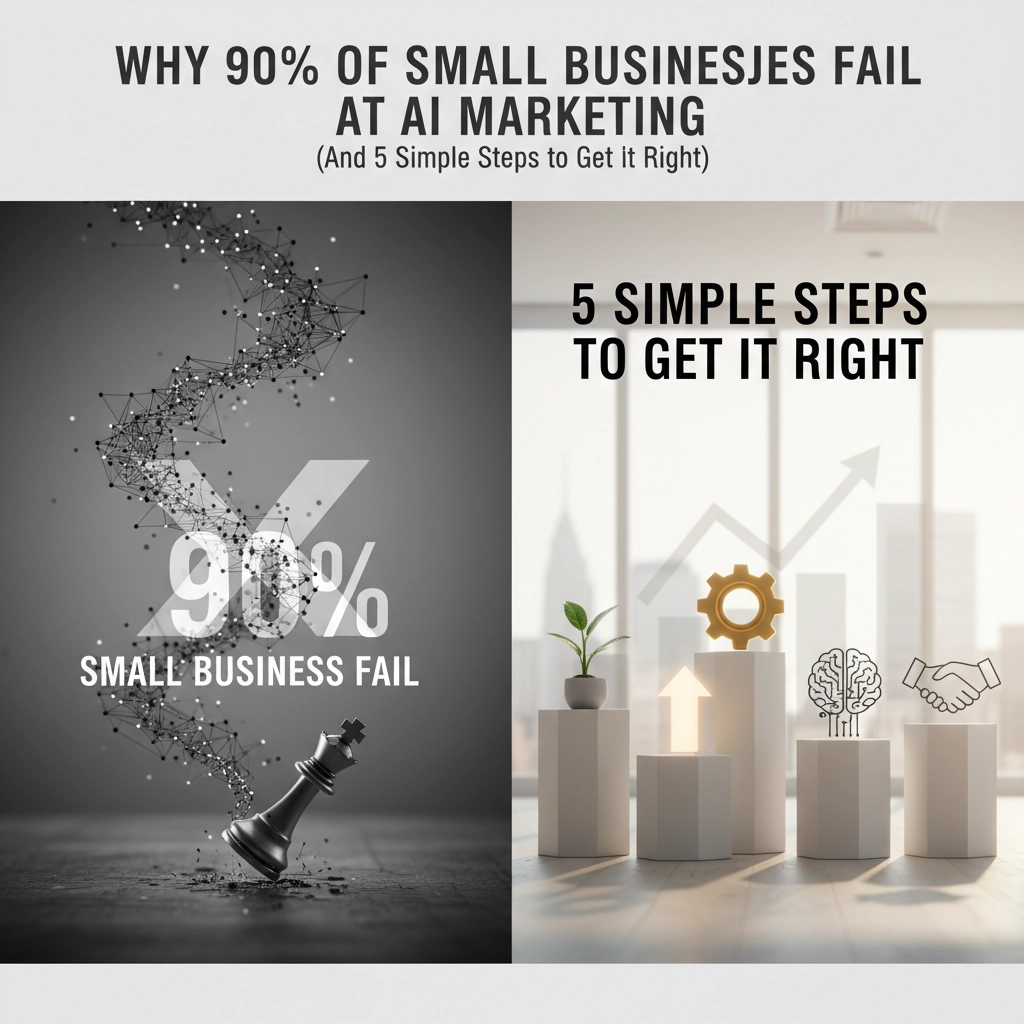Let's get real for a second. AI marketing is everywhere right now, and if you're a small business owner, you've probably felt the pressure to jump on the bandwagon. Maybe you've even tried a few AI tools already.
Here's the tough truth: most small businesses are getting it completely wrong.
Recent data shows that small business AI adoption has actually dropped from 42% to 28% in just one year. That's not because the technology got worse, it's because people are realizing their AI experiments aren't delivering the results they expected.
And when it comes to AI projects in general? We're looking at failure rates between 70-85%. For generative AI specifically, MIT research found that a whopping 95% of enterprise pilots are failing to deliver value.
But here's the good news: the businesses that get AI marketing right are seeing incredible results. The difference isn't the tools they're using, it's how they're using them.
Why Most Small Businesses Crash and Burn With AI Marketing
Before we talk solutions, let's diagnose the problem. Most small business owners approach AI marketing like they're buying a magic wand. They hear about ChatGPT or some shiny new marketing automation tool, sign up, and expect instant results.
That's not how this works.

The "Shiny Object" Trap
The biggest mistake? Implementing AI marketing tools without knowing why you're doing it. I see this constantly, business owners get excited about AI-generated content or automated email sequences, but they can't answer basic questions like:
- What specific business problem are you trying to solve?
- How will you measure success?
- What happens if the tool doesn't work as expected?
Without clear answers, you're just throwing money at technology and hoping for the best.
Data Chaos
Here's something nobody talks about: AI is only as good as the data you feed it. Most small businesses have what I call "data chaos", customer information scattered across spreadsheets, outdated CRM systems, and duplicate records everywhere.
When you plug AI marketing tools into messy data, you don't get intelligent automation. You get expensive chaos that amplifies your existing problems.
The Internal Resistance Problem
Let's say you buy an AI tool that can write email campaigns. Sounds great, right? But if your team doesn't understand why you're using it or how it fits into their workflow, they'll resist it. Or worse, they'll use it wrong and blame the technology when it doesn't work.

The 5-Step Formula That Actually Works
Okay, enough doom and gloom. Here's how to implement AI marketing the right way: based on what the successful 10-30% of businesses are actually doing.
Step 1: Start With One Specific Pain Point
Don't try to revolutionize your entire marketing operation overnight. Pick one specific problem that's costing you time or money right now.
Good examples:
- "I spend 3 hours every week writing social media captions"
- "Our email open rates are terrible because we send generic blasts"
- "I can't keep up with responding to customer inquiries on our website"
Bad examples:
- "We need to modernize our marketing"
- "AI will help us compete better"
- "Everyone else is using AI, so we should too"
See the difference? The good examples are specific, measurable problems. The bad examples are vague goals that won't guide your decision-making.
Step 2: Clean Up Your Data First
This step isn't sexy, but it's critical. Before you implement any AI marketing tools, you need to get your data house in order.
Here's your data cleanup checklist:
- Consolidate customer information into one system
- Remove duplicates and outdated contacts
- Standardize how you categorize customers (by industry, purchase history, etc.)
- Set up tracking for the metrics that matter to your business
I know this sounds boring, but think of it like this: you wouldn't build a house on a shaky foundation. Don't build your AI marketing strategy on messy data.

Step 3: Choose Tools That Solve Your Specific Problem
Now comes the fun part: picking your AI marketing tools. But here's the key: don't start with the tool, start with the problem from Step 1.
If your problem is writing social media content, look at AI writing tools like Jasper or Copy.ai. If it's email personalization, consider tools like Mailchimp's AI features or Klaviyo. If it's customer service, explore chatbot solutions.
Pro tip: Start with tools that integrate with systems you already use. If you're already using WordPress, look for AI plugins. If you're on Shopify, find Shopify-specific AI apps. The easier the integration, the more likely you'll actually use it.
Step 4: Train Your Team (Including Yourself)
This might be the most overlooked step. AI marketing tools aren't "set it and forget it" solutions. They require ongoing management and optimization.
Schedule training sessions where you and your team learn:
- How to use the tool effectively
- How to interpret the results
- When to intervene and make adjustments
- How the tool fits into your existing workflows
Make sure everyone understands that AI is meant to enhance human creativity and efficiency, not replace human judgment.
Step 5: Measure, Adjust, and Scale
Here's where most businesses drop the ball. They implement an AI marketing tool, see some initial results, and then… nothing. They don't track performance, they don't make improvements, and they don't expand what's working.
Set up a monthly review process:
- Are you solving the original problem you identified?
- What's working better than expected?
- What needs adjustment?
- Are you ready to tackle a second problem with AI?
Only after you've mastered AI for one specific use case should you consider expanding to other areas.

The Real Secret to AI Marketing Success
Want to know what separates the winners from the losers? It's not the tools they use or how much they spend. It's their mindset.
Successful small businesses treat AI marketing like a business process, not a magic solution. They start small, measure everything, and gradually build their capabilities.
The failing businesses treat AI like a lottery ticket. They make big investments, expect immediate results, and give up when the magic doesn't happen.
Your Next Steps
If you're ready to join the minority of small businesses that actually succeed with AI marketing, here's what to do right now:
- Write down one specific marketing problem that's costing you time or money
- Audit your customer data and clean up what you find
- Research 2-3 AI tools that specifically address your problem
- Start with a free trial or low-cost option
- Set a calendar reminder to review your results in 30 days
Remember: the goal isn't to implement AI everywhere at once. It's to solve one problem really well, then build from there.
And if you need help figuring out where to start or which tools make sense for your business, that's exactly what we help small businesses with. We've seen what works and what doesn't, and we can help you skip the trial-and-error phase.
The AI marketing revolution is real, but it's not going to happen overnight. The businesses that take a strategic, step-by-step approach are the ones that will still be winning five years from now.
Are you ready to be one of them?




0 Comments